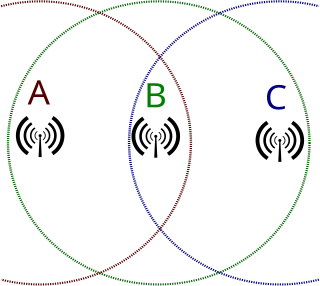Related Research Articles

IEEE 802.11 is part of the IEEE 802 set of local area network (LAN) technical standards, and specifies the set of medium access control (MAC) and physical layer (PHY) protocols for implementing wireless local area network (WLAN) computer communication. The standard and amendments provide the basis for wireless network products using the Wi-Fi brand and are the world's most widely used wireless computer networking standards. IEEE 802.11 is used in most home and office networks to allow laptops, printers, smartphones, and other devices to communicate with each other and access the Internet without connecting wires. IEEE 802.11 is also a basis for vehicle-based communication networks with IEEE 802.11p.

Carrier-sense multiple access with collision avoidance (CSMA/CA) in computer networking, is a network multiple access method in which carrier sensing is used, but nodes attempt to avoid collisions by beginning transmission only after the channel is sensed to be "idle". When they do transmit, nodes transmit their packet data in its entirety.
In telecommunications and computer networks, a channel access method or multiple access method allows more than two terminals connected to the same transmission medium to transmit over it and to share its capacity. Examples of shared physical media are wireless networks, bus networks, ring networks and point-to-point links operating in half-duplex mode.

In computer networking, a wireless access point, or more generally just access point (AP), is a networking hardware device that allows other Wi-Fi devices to connect to a wired network. As a standalone device, the AP may have a wired connection to a router, but, in a wireless router, it can also be an integral component of the router itself. An AP is differentiated from a hotspot, which is a physical location where Wi-Fi access is available.

In IEEE 802 LAN/MAN standards, the medium access control (MAC), also called media access control, is the layer that controls the hardware responsible for interaction with the wired or wireless transmission medium. The MAC sublayer and the logical link control (LLC) sublayer together make up the data link layer. The LLC provides flow control and multiplexing for the logical link, while the MAC provides flow control and multiplexing for the transmission medium.
Contention-free pollable (CF-Pollable) is a state of operation for wireless networking nodes. The condition is saying that the node is able to use the Point Coordination Function, as opposed to the Distributed Coordination Function, within a wireless LAN.
IEEE 802.11e-2005 or 802.11e is an approved amendment to the IEEE 802.11 standard that defines a set of quality of service (QoS) enhancements for wireless LAN applications through modifications to the media access control (MAC) layer. The standard is considered of critical importance for delay-sensitive applications, such as Voice over Wireless LAN and streaming multimedia. The amendment has been incorporated into the published IEEE 802.11-2007 standard.
Distributed coordination function (DCF) is the fundamental medium access control (MAC) technique of the IEEE 802.11-based WLAN standard. DCF employs a carrier-sense multiple access with collision avoidance (CSMA/CA) with the binary exponential backoff algorithm.

In wireless networking, the hidden node problem or hidden terminal problem occurs when a node can communicate with a wireless access point (AP), but cannot directly communicate with other nodes that are communicating with that AP. This leads to difficulties in medium access control sublayer since multiple nodes can send data packets to the AP simultaneously, which creates interference at the AP resulting in no packet getting through.
IEEE 802.15.4 is a technical standard which defines the operation of a low-rate wireless personal area network (LR-WPAN). It specifies the physical layer and media access control for LR-WPANs, and is maintained by the IEEE 802.15 working group, which defined the standard in 2003. It is the basis for the Zigbee, ISA100.11a, WirelessHART, MiWi, 6LoWPAN, Thread, Matter and SNAP specifications, each of which further extends the standard by developing the upper layers which are not defined in IEEE 802.15.4. In particular, 6LoWPAN defines a binding for the IPv6 version of the Internet Protocol (IP) over WPANs, and is itself used by upper layers like Thread.
IEEE 802.11i-2004, or 802.11i for short, is an amendment to the original IEEE 802.11, implemented as Wi-Fi Protected Access II (WPA2). The draft standard was ratified on 24 June 2004. This standard specifies security mechanisms for wireless networks, replacing the short Authentication and privacy clause of the original standard with a detailed Security clause. In the process, the amendment deprecated broken Wired Equivalent Privacy (WEP), while it was later incorporated into the published IEEE 802.11-2007 standard.
Wireless Multimedia Extensions (WME), also known as Wi-Fi Multimedia (WMM), is a Wi-Fi Alliance interoperability certification, based on the IEEE 802.11e standard. It provides basic Quality of service (QoS) features to IEEE 802.11 networks. WMM prioritizes traffic according to four Access Categories (AC): voice (AC_VO), video (AC_VI), best effort (AC_BE), and background (AC_BK). However, it does not provide guaranteed throughput. It is suitable for well-defined applications that require QoS, such as Voice over IP (VoIP) on Wi-Fi phones (VoWLAN).
Multiple Access with Collision Avoidance for Wireless (MACAW) is a slotted medium access control (MAC) protocol widely used in ad hoc networks. Furthermore, it is the foundation of many other MAC protocols used in wireless sensor networks (WSN). The IEEE 802.11 RTS/CTS mechanism is adopted from this protocol. It uses RTS-CTS-DS-DATA-ACK frame sequence for transferring data, sometimes preceded by an RTS-RRTS frame sequence, in view to provide solution to the hidden node problem. Although protocols based on MACAW, such as S-MAC, use carrier sense in addition to the RTS/CTS mechanism, MACAW does not make use of carrier sense.
The IEEE 802.11 family of standards describe the DCF protocol, which controls access to the physical medium. A station must sense the status of the wireless medium before transmitting. If it finds that the medium is continuously idle for DCF Interframe Space (DIFS) duration, it is then permitted to transmit a frame. If the channel is found busy during the DIFS interval, the station should defer its transmission.
The network allocation vector (NAV) is a virtual carrier-sensing mechanism used with wireless network protocols such as IEEE 802.11 (Wi-Fi) and IEEE 802.16 (WiMax). The virtual carrier-sensing is a logical abstraction which limits the need for physical carrier-sensing at the air interface in order to save power. The MAC layer frame headers contain a duration field that specifies the transmission time required for the frame, in which time the medium will be busy. The stations listening on the wireless medium read the Duration field and set their NAV, which is an indicator for a station on how long it must defer from accessing the medium.
Short Interframe Space (SIFS), is the amount of time in microseconds required for a wireless interface to process a received frame and to respond with a response frame. It is the difference in time between the first symbol of the response frame in the air and the last symbol of the received frame in the air. A SIFS time consists of the delay in receiver RF, PLCP delay and the MAC processing delay, which depends on the physical layer used. In IEEE 802.11 networks, SIFS is the interframe spacing prior to transmission of an acknowledgment, a Clear To Send (CTS) frame, a block ack frame that is an immediate response to either a block ack request frame or an A-MPDU, the second or subsequent MPDU of a fragment burst, a station responding to any polling a by point coordination function and during contention free periods of point coordination function.
Reduced Interframe Space (RIFS) is one of the new features introduced in IEEE 802.11n to improve its efficiency. RIFS is the time in micro seconds by which the multiple transmissions from a single station are separated. RIFS is used when no SIFS separated response frames are expected from the receiver. The value of RIFS is 2μs for 802.11n phy.
Extended Interframe space (EIFS) is used in IEEE 802.11 based WLANs. If a previously received frame contains an error then a station has to defer EIFS duration instead of DIFS before transmitting a frame. This is because, although this station was not able to decode the frame, it could be that the intended receiver could decode the frame. It should have the opportunity to return an Acknowledgment frame; the EIFS ensures the transmission of the Ack can proceed without interference from those not able to decode the frame.
Arbitration inter-frame spacing (AIFS), in wireless LAN communications, is a method of prioritizing one Access Category (AC) over the other, such as giving voice or video priority over email. AIFS functions by shortening or expanding the period a wireless node has to wait before it is allowed to transmit its next frame. A shorter AIFS period means a message has a higher probability of being transmitted with low latency, which is particularly important for delay-critical data such as voice or streaming video.
IEEE 802.11ah is a wireless networking protocol published in 2017 called Wi-Fi HaLow as an amendment of the IEEE 802.11-2007 wireless networking standard. It uses 900 MHz license-exempt bands to provide extended-range Wi-Fi networks, compared to conventional Wi-Fi networks operating in the 2.4 GHz and 5 GHz bands. It also benefits from lower energy consumption, allowing the creation of large groups of stations or sensors that cooperate to share signals, supporting the concept of the Internet of things (IoT). The protocol's low power consumption competes with Bluetooth, LoRa, and Zigbee, and has the added benefit of higher data rates and wider coverage range.
References
- ↑ "Point Coordination Function (PCF)". wireless-center.net. Archived from the original on February 1, 2009. Retrieved 2008-02-26.
- ↑ "IEEE 802.11-2007 Standard" (PDF).